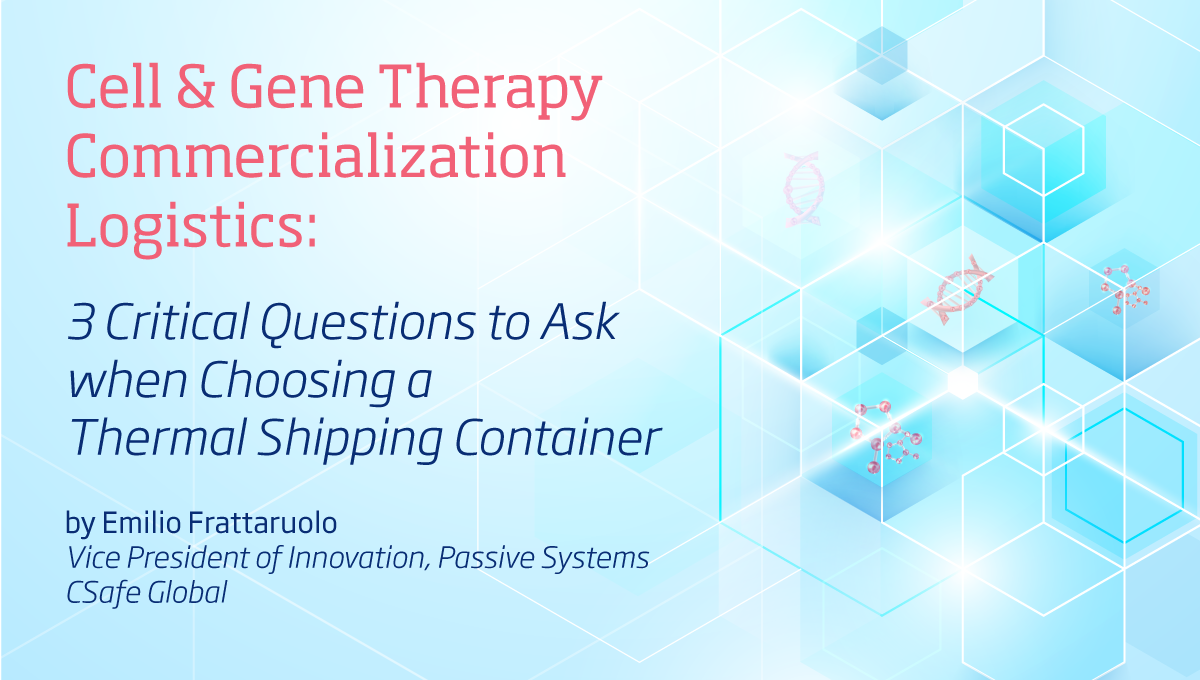Among today’s temperature-sensitive pharmaceutical products requiring specialized handling, transport and storage, cell and gene therapies (CGT) need even more precise logistical planning than many others. A given CGT product is typically produced in single individualized doses or in small batches to treat a debilitating or life-threatening genetic disease. Because CGT therapies are highly individualized, each supply chain is unique and each selecting partners and providers is critical.
CGT producers must work closely with shipping partners and thermally protective packaging (TPP) providers. Ideally, you want to partner with an experienced, global supplier that won’t just hand you a temperature-controlled container and walk away. A preferred thermal packaging provider offers guidance by conducting a gap analysis to identify and prioritize your tactical and strategic needs and also can scale as your process moves from clinical development through regulatory approval to commercial operations. Similarly, your supplier should be able to perform physical testing and thermal modeling, provide documentation to meet GDP requirements, and offer advisory support to prepare for regulatory approval and potential audits down the line.
It’s also never too early to begin your container selection process. When CGT producers and supply chain partners have time to fully vet and standardize the shipping process – including packing and handling the containers – they can reliably and cost-effectively safeguard these high-value products. Early container selection is especially important when a product requires customizations to the packaging design or its monitoring capabilities.
As you evaluate available thermal shipping containers for your CGT products, consider these questions.
#1 What does the overall supply chain look like for a given CGT product?
As mentioned, each supply chain is unique based on the individual CGT product, but in general the steps are:
- Clinician extracts biological materials from the patient.
- Raw materials transported to the CGT manufacturing site.
- CGT product is manufactured.
- Therapy delivered to clinical setting.
- Clinician infuses treatment into the patient.
There are special considerations for autologous vs. allogeneic therapies.
Autologous therapies use one patient’s whole blood, blood products, marrow or other tissue. The CGT manufacturer uses that as biological starting material and modifies it to produce a customized therapy. Once the individualized CGT product has been produced, it is transported back to the clinical setting to be infused into the initial donor patient in a closed-loop scenario that requires tightly coordinated handoffs.
Allogeneic therapies use blood or tissue from one donor patient to produce multiple doses of the CGT product which will ultimately be used to treat the donor patient and compatible patients who have been deemed eligible to receive it. Allogeneic therapies are produced in larger quantities (compared to the single-dose manufacturing process used for autologous therapies). Individual doses of the finished therapy are distributed to multiple sites to be infused into multiple patients — each requiring its own temperature-controlled delivery process.
Whether it’s an autologous or allogeneic product, the CGT supply chain requires unprecedented levels of coordination for scheduling each shipment and maintaining a constant temperature.
#2 What durations do you expect to encounter for your shipment, in terms of storage and transport?
Autologous shipments — The timing and duration these shipments will vary based on patient location. Both the raw materials and the high value finished CGT therapy are irreplaceable. Ensuring that the courier arrives at the collection site with a best-in-class, pre-conditioned shipping container already on hand will save precious time.
Allogeneic shipments — These shipment times will also vary as they are generally distributed to multiple locations. Longer distances will require more time and possibly a “layover” to accommodate transport schedules. These shipments need a container with shipping delay protection.
#3 Are any special handling requirements required?
Failures at any step in this highly coordinated delivery process can have serious clinical consequences for the patient and significant financial consequences for the biopharmaceutical company. During your due diligence effort, this brief checklist can help ensure that you select a container with the necessary design capabilities:
- Are chain-of-custody checks required? The most reliable thermal shippers are those that have end-to-end tracking capabilities with real-time visibility into the shipment’s location and condition.
- Who will be packing the container at the collection site and at the CGT manufacturing site? Because this will rarely be the same person, a holistic packaging design is important. This is a foolproof design that uses intuitive engineering simple enough to ensure error-free use.
- Will the thermal shipper need to act as a temporary frozen storage unit for any duration along the route? Refrigerator or freezer capacity at interim points along the route is an important consideration in container selection. Your thermal shipper should have shipping delay protection to ensure the product remains in the required setpoint temperature range at all times.
- Does the container have adequate monitoring and tracking devices? The range of tracking devices that can fit inside the container are vast and can capture and convey real-time data related to temperature, shock and vibration, location, geofencing and more. Understanding where you need continuous visibility is essential for overall risk mitigation.
- Is open- and closed-lid tracking required? For high-value, temperature-sensitive CGT products, every time the shipping container lid is opened (and how long it stays open), creates risk for temperature excursions or potential theft. Securing thermal packaging with real-time tracking and alerts for lid opening and closing helps to eliminate these risks. Container suppliers who offer this type of tracking should also carry out thermal testing and risk modeling for various open-lid and delayed-transit scenarios to ensure optimal performance.

